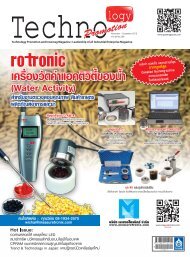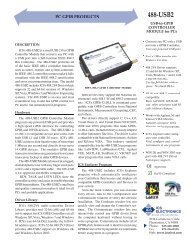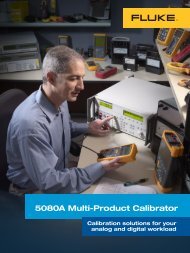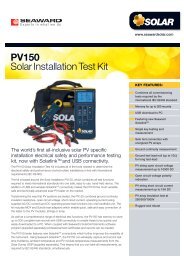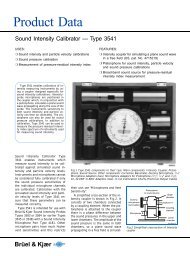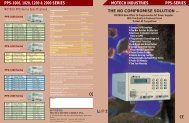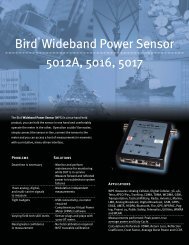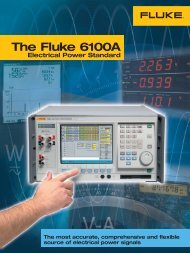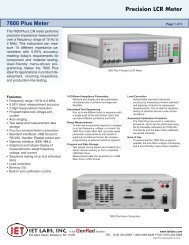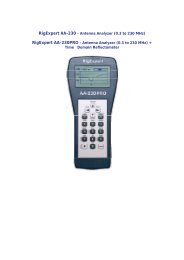CNT-90
CNT-90
CNT-90
You also want an ePaper? Increase the reach of your titles
YUMPU automatically turns print PDFs into web optimized ePapers that Google loves.
<strong>CNT</strong>-<strong>90</strong>Timer/Counter/AnalyzerA REVOLUTION IN TIME &FREQUENCY ANALYSIS Fastest: 250k measurements/sto internal memory and 2k/s viaGPIB Highest resolution: 12 digits/s(freq.), 100 ps (time), 0.001(phase) 14 digits display Frequency range: 300 MHz standard;3, 8 and 14 GHz optional Unique ease-of-use:Multi-parameter display andgraphical presentation of results USB and GPIB as standard Outstanding performance/price ratioWith the new <strong>CNT</strong>-<strong>90</strong> timer/counter/analyzer, Pendulum Instruments nowoffers The Ultimate Tool for measurement, analysis and calibration ofFrequency, Time Interval or Phase. Whether in test systems, on the R&Dbench, in the calibration lab or out in the field, the <strong>CNT</strong>-<strong>90</strong> is thestate-of-the-art timer/counter/analyzer and outperforms any existing counteron the market. The <strong>CNT</strong>-<strong>90</strong> is the worlds fastest timer/counter/analyzerand offers a unique ease-of-use with graphical display and improved controlover measurement at an outstanding price.Outstanding Performance/Price ratioThe <strong>CNT</strong>-<strong>90</strong> timer/counter/analyzeroutperforms any counter on the market,independent of measurement task. The<strong>CNT</strong>-<strong>90</strong> offers ultimate and unique controlof measurement and is the choice for allneeds and budgets - giving you outstandingperformance for the price of a standardcounter.Leading World-Class PerformanceThe basic performance of the <strong>CNT</strong>-<strong>90</strong> isWorld-leading compared to competition:- 2k individual triggered measurements persecond via GPIB/USB the <strong>CNT</strong>-<strong>90</strong> can saveyou up to <strong>90</strong>% testing time (and thus money)in test systems by increased throughput.- High resolution is vital for R&D andproduction testing. <strong>CNT</strong>-<strong>90</strong> meets thisrequirement with 100 ps single shot or 12digits/s, thus following very small time andfrequency changes. That is 2 more digitsthan other interpolating counters. Obtainedvalues are displayed with up to 14 digits.- Modulation Domain Analysis is performedby capturing very fast frequency changes inreal time, thanks to the high 250kmeasurement speed and the large memorydepth of 750k readings.- For calibration purposes, results arequickly obtained. The <strong>CNT</strong>-<strong>90</strong> offers veryhigh accuracy through very stable internalOCXO time base, very low systematic timeinterval A-B error and of course very highresolution.- Wide frequency range, up to 14 GHz,covers most frequency measurement needsfrom DC to microwave. There is no need toinvest in a separate microwave counter.Ease-of-UseThe menu-oriented settings reduce the riskfor mistakes. Valuable signal informationgiven as numerical results with multiparameterdisplay removes the need forother instruments like DVM’s and Scopes.The graphical presentation of results(histograms, trends, modulation domain etc)gives a much better understanding ofrandom signal distribution and measurementchanges vs time, from slow drift to fast jitterand modulation.The intelligent Auto-trigger automaticallysets optimum trigger level and hysteresis,adapted to the actual input signal.Excellent connectivity to computersThe <strong>CNT</strong>-<strong>90</strong> is delivered with both USBandGPIB high-speed interfaces as standard.This eliminates the need to invest in anextra GPIB interface for your PC since USBis present everywhere.Plug-and-Play in existing testsystemsThe GPIB interface comes in two modes:SCPI/1999 plus a 53131A emulation modefor easy implementation in test systemsoriginally designed for other brands.This instant “plug-and-play” featurefacilitates the exchange of the timer/counter/analyzer and reduces the need tore-program existing system commands.Improved control over measurementstart/stop<strong>CNT</strong>-<strong>90</strong> takes the art of measurement to thetop with features such as arming, adjustablearming delay, trigger hold-off and limitqualifying.Arming enables full control of both startand stop of the measurement of time orfrequency in complex signals.Frequency burst parameters are automaticallydetected due to the adjustablearming delay and trigger hold-off, both with10 ns resolution.The feature limit qualifying skips unwantedparameter values.The state-of-art <strong>CNT</strong>-<strong>90</strong> is the revolution -it is the only tool for time & frequencymeasurement, analysis and calibration youwill ever need.
Revolutionary Graphical PresentationOne of the unique features of the<strong>CNT</strong>-<strong>90</strong> is the graphical display andthe menu oriented settings. Thenon-expert can easily make correct settingswithout risking costly mistakes.The multi-parameter display with additionalauxiliary measurement valuessuch as V max /V min /V p-p in frequencymeasurements, and frequency/attenuation/phasemeasurements, eliminates theneed for extra test instruments and providesyou direct answers to frequentlyasked questions, like “What is the attenuationand phase shift of this filter?”Measurement values are presented bothnumerically and graphically. The graphicalpresentation of results (histograms,trends etc.) gives a much better understandingof the nature of jitter. It alsoprovides you with a much better view ofchanges vs time, from slow drift to fastmodulation (trend plot). Three statisticalviews of the same data set can be viewed:Numerical, Histogram and Trend. It isvery easy to capture and toggle betweenviews of the same data (see figure 4, 5&6).When adjusting a frequency source togiven limits, the graphic display gives fastand accurate visual calibration guidance.Figure 1: Display showing phase value, frequency,attenuation V A /V B , and auxiliary paremeters.Figure 4: Display showing different statisticalparameters viewed at the same time.Figure 2: Measure function selection menu, shownwith measured results.Figure 5: Display showing the trend (signal overtime) of sampled data.Figure 3: Input parameter setting menu shown withmeasured result.Figure 6: The same result as in figure 5, nowdisplayed as a histogram.
Additional TechnicalFeatures<strong>CNT</strong>-<strong>90</strong> not only offers leading World-Classperformance, it is the ultimate tool for morespecialized measurement. Some moreunique featues of the <strong>CNT</strong>-<strong>90</strong> are:- Zero dead-time technique and continuoustime-stamping of trigger events. Fasttime-stamping of trigger events enablescapture of ALL individual periods,back-to-back without dead-time, up to 250kmeasurements/s. This feature is veryvaluable in mechanical (e.g. rotationalencoder testing) and medical (e.g. nerveimpulse/respiratory cycles) measurements.- SMART Time Interval measurementsthrough single-pass technique. Unliketraditional methods where you needed todefine the start and stop channel onbeforehand (e.g. Time A-B), you can nowlet <strong>CNT</strong>-<strong>90</strong> detect start and stopautomatically. No more false results due tothe stop signal occurring before the startsignal.- TRUE Phase and Duty Cycle measurementsthrough single-pass technique.Traditional methods calculate Phase as(Time Interval A-B)/Period*360° and DutyCycle as (Pulse width)/Period where TimeInterval A-B, Pulse Width and Period weremeasured separately, and notsimultaneously. The single-pass phase andduty cycle measurement in <strong>CNT</strong>-<strong>90</strong> enablesTRUE phase measurements between signalswith a varying frequency. This feature isvery valuable to verify the relative phasebetween quadrature output pulses (<strong>90</strong>)from rotational encoders, where rotationspeed may vary during the measurement.- Limit qualifying lets the user accept orreject measurement values inside or outsideset limits. This is a very handy tools formaking correct calculation of statisticalparameters e.g. to verify the rms jitter ofdigital pulses that appear in discrete clusters(e.g. in CD-players or HDB3-coded data).By setting limits you can isolate one clusterin the calculation.- Measurement pacing sets an accuratesample rate for the measurement, ensuringthat samples are taken at exact andequi-distant intervals. Setting e.g. the pacingtime to 600s (one measurement every 10minutes for a 24 hr monitoring period),reduces the amount of data to 144measurement samples equally spread overthe day.- Hysteresis compensation in Time Intervalmeasurements reduces trigger level errorfrom the typical 15-20 mV found in mostcounters on the market today, down to typ2.5 mV. This means 6-8 times improvedtrigger precision in critical time intervalmeasurements.If <strong>CNT</strong>-<strong>90</strong> can’t make the measurement,no other counter can!<strong>CNT</strong>-<strong>90</strong> SpecificationsMeasuring FunctionsAll measurements are displayed with a large main parametervalue and smaller auxiliary parameter values(with less resolution). Some measurements are onlyavailable as auxiliary parameters.Frequency A, B, CRange:Input A, B: 0.001 Hz to 300 MHzInput C (option): Up to 3 GHz, 8 GHz or 14 GHzResolution: 12 digits in 1s measuring timeAux parameters: Vmax, Vmin, Vp-pFrequency Burst A, B, CFrequency and PRF of repetitive burst signals can bemeasured without external control signal and withselectable start arming delay.Functions: Frequency in burst (in Hz)PRF (in Hz)Number of cycles in burstRange:Input A, B, C: See Frequency spec.Minimum burst duration:40ns (80ns above 160 MHz)Minimum pulses in burst:Input A or B: 3 (6 above 160 MHz)Input C: 3 x prescaler factorPRF range: 0.5 Hz to 1 MHzStart Delay Range: 10 ns to 2s, 10 ns resolutionAux parameters: PRF, number of cycles in burstPeriod A, B, C AverageRange:Input A, B: 3.3 ns to 1000sInput C: 330 ps to 10 ns (option 10)125 ps to 5 ns (option 13)Resolution: 100 ps (single); 12 digits/s (average)Aux parameters: Vmax, Vmin, Vp-pRatio A/B, B/A, C/A, C/BRange: (10 -9 )to10 11Input Frequency:Input A, B: 0.1 Hz to 300 MHzInput C (option): Up to 3 GHz, 8 GHz or 14 GHzAux parameters: Freq 1, Freq 2Time Interval A to B, B to A, A to A, B to BRange:Normal calculation: -5 ns to +10 6 sSmart calculation:-10 6 sto+10 6 sResolution: 100 psMin. Pulse width: 1.6 nsSmart Calculation: Smart Time Interval to determinesign (A before B or A after B)Positive and Negative Pulse Width A, BRange: 1.6 ns to 10 6 sMin. Pulse width: 1.6 nsAux parameters: Vmax,Vmin, Vp-pRise and Fall Time A, BRange: 700 ps to 1000sTrigger levels: 10% and <strong>90</strong>% of signal amplitudeMin. Pulse width: 1.6 nsAux parameters: Slew rate, Vmax, VminPhase A Relative B, B relative ARange: -180 to +360Resolution: 0.001 to 10 kHz,decreasing to 1° >10 MHzResolution can be improved via averaging (Statistics)Frequency Range: up to 160 MHzAux parameters: Freq (A), Va/Vb (in dB)Positive and Negative Duty Factor A, BRange: 0.000001 to 0.999999Frequency Range: 0.1 Hz to 300 MHzAux parameters: Period, pulse widthVmax, Vmin, Vp-p A, BRange: -50V to +50V, -5V to +5VRange is limited by the specification for max inputvoltage without damage (see input A, B)Frequency Range: DC, 1 Hz to 300 MHzMode: V max, V min, V p-pResolution: 2.5mVVmax Aux parameters: Vmin, Vp-pVmin Aux parameters:Vmax, Vp-pVp-p Aux parameters:Vmin, VmaxTime stamping A, BRaw time stamp data together with pulse counts on inputA or B, accessible via GPIB or USB only.Max sample speed: See GPIB specificationsMax frequency: 160 MHzTimestamp resolution: 100 psInput and Output SpecificationsInputs A and BFrequency Range:DC-Coupled: DC to 300 MHzAC-Coupled: 10 Hz to 300 MHzImpedance: 1M 20 pF or 50VSWRTrigger Slope: Positive or negativeMax. channel timing difference: 500 psSensitivity:DC-100 MHz: 10 mV rms100-200 MHz: 20 mV rms200-300 MHz: 40 mV rmsAttenuation: x1, x10Dynamic Range (x1): 30 mV p-p to 10V p-p within±5V windowTrigger Level: Read-Out on displayResolution: 2.5 mVUncertainty (x1): ±(10 mV + 1% of trigger level)AUTO Trigger Level: Trigger level is automaticallyset to 50% point of input signal(10% and <strong>90</strong>% for Rise/Fall Time)AUTO Hysteresis:Time: Min hysteresis window (hysteresiscompensation)Frequency: One third of input signal amplitudeAnalog noise reduction filter:Nominal 100 kHz, RC-type.Digital Low Pass Filter:Variable 1 Hz to 50 MHz cut-offfrequencyMax Voltage Without Damage:1M: 350V (DC + AC pk) to 440 Hz, fallingto 12V rms (x1) at 1 MHz50: 12V rmsConnector: BNCInput C (Option 10)Operating Input Voltage Range:100 to 300 MHz: 20 mV rms to 12V rms0.3 to 2.5 GHz: 10 mV rms to 12V rms2.5 to 2.7 GHz: 20 mV rms to 12V rms2.7 to 3.0 GHz: 40 mV rms to 12V rmsPrescaler Factor: 16Impedance: 50 nominal, VSWR
Input C (Option 13)Operating Input Voltage Range:200 to 500 MHz: 20 mV rms to 7 V rms0.5 to 3.0 GHz: 10 mV rms to 7 V rms3.0 to 4.5 GHz: 20 mV rms to 7 V rms4.5 to 6.0 GHz: 40 mV rms to 7 V rms6.0 to 8 GHz: 80 mV rms to 7 V rmsPrescaler Factor: 256Impedance: 50 nominal, VSWR 1 Vrms sine into 50Arming Input: Arming of all measuring functionsImpedance: Approx. 1 kFrequency Range:DC to 80 MHzRear panel measurement inputs: A, B, C (option)Impedance: 1M//50 pF or 50 (VSWR 2:1)Connectors: Type N female for rear input CBNC for all other inputs/outputsAuxiliary FunctionsTrigger Hold-OffTime Delay Range: 20 ns to 2s, 10 ns resolutionExternal Start and Stop ArmingModes: Start, Stop, Start and Stop ArmingInput channels: A, B or EMax rep. Rate for Arming signal:Channel A,B: 160 MHzChannel E: 80 MHzStart Time Delay Range: 20 ns to 2s, 10 ns resolutionStatisticsFunctions:Maximum, Minimum, Mean,max-Min, Standard Deviation andAllan DeviationNumeric, histograms or trend plotsDisplay:Sample Size: 2to2x10 9 samplesLimit qualifier:Measurement pacingPacing time range: 2 us to 1000sTime Base OptionsOFF or Capture valuesabove/below/inside or outside limitsMathematicsFunctions:(K*X+L)/M and (K/X+L)/M. X iscurrent reading and K, L and M areconstants; set via keyboard or asfrozen reference value (X 0 )Other FunctionsMeasuring Time: 20 ns to 1000s for Frequency, Burstand Period Average. Single cycle forother measuring functionsTimebase Reference: Internal, External or AutomaticDisplay Hold: Freezes result, until a new measurementis initiated via RestartLimit alarm: Graphical indication on front paneland/or SRQ via GPIBLimit values: Lower limit, Upper limitSettings: OFF or Alarm if value isabove/below/inside or outside limitsOn alarm: STOP or CONTINUEDisplay: Numeric + GraphicStored instrument set-ups: 17 instrument setups can besaved/recalled from internal non-volatilememory. 10 can be user protected.Display: Backlit LCD Graphics screen formenu control, numerical read-out andstatus informationNumber of digits: 14 digits in numerical modeResolution: 320*97 pixelsGPIB InterfaceCompatibility: IEEE 488.2-1987, SCPI 199953131A compatibility modeInterface Functions: SH1, AH1, T6, L4, SR1, RL1,DC1, DT1, E2Max. measurement RateVia GPIB: 2k readings/s, individually triggeredTo Internal Memory: 250k readings/sInternal Memory Size: Up to 750k readings.USB InterfaceUSB version: 1.1 FullMax. measurement Rate: See GPIB dataCalibrationMode: Closed case, menu controlledCal. Frequencies: 0.1, 1, 5, 10, 1.544 and 2.048 MHzOption model: std 30/<strong>90</strong> 40/<strong>90</strong>Time base type: Standard OCXO OCXOUncertainty due to:-Ageing.per 24hper monthper year-Temperature variation: 0°C-50°C20°C-26°C (typ. values)Short term stability: =1s(root Allan Variance) = 10sPower-on stability-Deviation vs final value after 24hr on time,after a warm-up time of:Typical total uncertainty, for operating temperature20°C to 26°C, at 2 (95%) confidence interval:- 1 year after calibration- 2 years after calibration1) After 1 month of continuous operationn.a.



